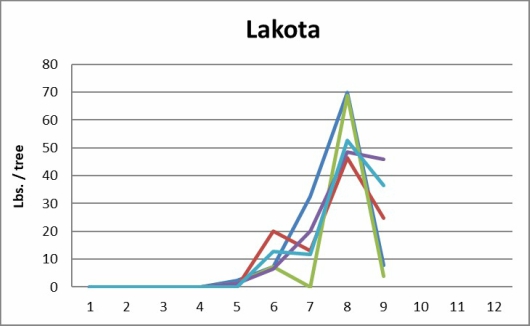Lakota

Table 1. Yield and quality of ‘Lakota’ over 9 years (2009-2017).
| Cultivar | Avg. Yield | #Nuts/lb. | %Kernal | Cluster Size | 50% shuck split | ||
| lbs./tree/year | |||||||
| Lakota | 12 | 54 | 58% | 3.6 | Sept. 27 | ||
| Pawnee | 5 | 47 | 56% | 2.1 | Sept. 10 | ||
Fig. 1. Individual tree yield of ‘Lakota’ 9 years (2009-2017). Each line indicates the yield of a separate tree.

Table 2. Average pest resistance of test cultivars in a sprayed orchard 2009-2017.
| Cultivar | Leaf ScabZ | Nut ScabY | Nut ScabX | Black Aphid DamageW |
| Avg. | Avg. | Worst | Avg. | |
| Lakota | 1.0 | 1.0 | 1.1 | 1.4 |
| Pawnee | 1.8 | 1.0 | 2.7 | 1.1 |
- z1 = no scab lesions, 2 = a few isolated lesions with restricted growth, 3 = multiple lesions with expanding growth, 4 = stem scab lesions or defoliation.
- y1 = no scab lesions, 2 = a few lesions with restricted growth, 3 = multiple lesions, 0% to 10% coverage, 4 = 11% to 50% coverage, 5 = 51% to 100% coverage or nut drop. Average damage seen on nuts over the tree.
- x1 = no scab lesions, 2 = a few lesions with restricted growth, 3 = multiple lesions, 0% to 10% coverage, 4 = 11% to 50% coverage, 5 = 51% to 100% coverage or nut drop. Maximum damage seen on any nut.
- w1 = no damage, 2 = light chlorotic spotting, 0% to 25% leaves affected, 3 = moderate chlorotic spotting, 26% to 75% chlorotic spotting, 4 = heavy chlorotic spotting, 76% to 100% leaves affected.
History
Lakota' was released in 2007 by the USDA for all growing regions (Thompson et al., 2007). 'Lakota' was selected for its high nut quality, high yield potential, early nut maturity, and excellent tree strength. 'Lakota' was selected from the cross 'Mahan' x 'Major' and was tested as USDA 64-6-502.
Comments
Early yields of ‘Lakota’ have been high (Table 1). In their eighth year they averaged 57 lbs., but then in year nine they were back down to 24 lbs. Cluster size of Lakota is large, averaging 3.6, and 5 and 6 nuts per cluster are not unusual. Any cultivar with this large of a cluster size will need to be crop thinned, likely from a very young age. Yes, this cultivar has a large yield potential, but it will be up to the grower to manage the tree so that yields are sustainable year to year.
I’m not sure what I think about ‘Lakota’ nut quality yet. The numbers in Table 1 above look pretty good. However, there has been a lot of variability in the nuts. Nut size on the trees has been anywhere from 46 to 67 nuts / lb. Even on the same tree in the same year you see a lot of variation. I suspect that when you have a large number of nuts in one cluster you may wind up with some nuts not getting fed as well and turning out smaller. Growers should be certain trees get enough water in the nut sizing period to keep nut size as large as possible in ‘Lakota’. Percent kernel was very good, and ‘Lakota’ usually shells out OK. I have in my notes in a couple of years that it was too dark. We also saw significant veining and spotting in 2016, which was a heavy crop year. It’s not clear to me, yet, if these problems can be alleviated via crop thinning. Harvest date is early, but still about 2.5 weeks after ‘Pawnee’. ‘Lakota’ does open more regularly than ‘Pawnee’ however, and will be one of the first cultivars you harvest.
‘Lakota’ has excellent scab resistance, likely inherited from ‘Major’. ‘Kanza’ is another ‘Major’ offspring that has excellent resistance. We maybe saw slight scab on a few clusters in our sprayed trial, but it was rare and we weren’t even sure it was scab. Most locations are reporting excellent scab resistance in ‘Lakota’. ‘Lakota’ trees are vigorous and I didn’t note any unusual susceptibility to insects. I would note that ‘Lakota’ trees at the Fairhope Station were more susceptible to bacterial leaf scorch, and several trees were removed for that reason. Although we have not had that issue here, it’s something to watch. Loss of leaves due to leaf scorch in a very productive cultivar like ‘Lakota’ would almost certainly lead to quality issues and increase alternate bearing.
‘Lakota’ is a type II, protogynous, cultivar. ‘Lakota’ is one of the only type II early harvest cultivars, the other being ‘Kanza’, and matches well with other early harvest type I cultivars like ‘Byrd’, ‘Mandan’, and ‘Pawnee’. ‘Lakota’ is also a good match with ‘Desirable’ for pollination.
‘Lakota’ is a new cultivar and we are still learning about it. The one thing we are certain of is that crop thinning will be essential with this cultivar. It simply sets too many nuts to not be crop thinned. However, the tree is very vigorous and so if you crop thin the precocity and productivity of this cultivar should be very good. The trees are very scab resistant and seem to have few issues. ‘Lakota’ is the only cultivar that combines medium to large nut size, excellent scab resistance, and a September harvest date. Several nurseries offer this cultivar for sale in Georgia and growers are experimenting with it more. Right now we recommend ‘Lakota’ for trial for those growers willing to control crop load.
